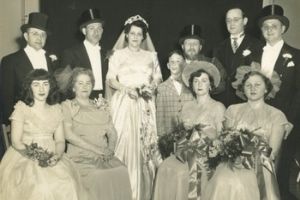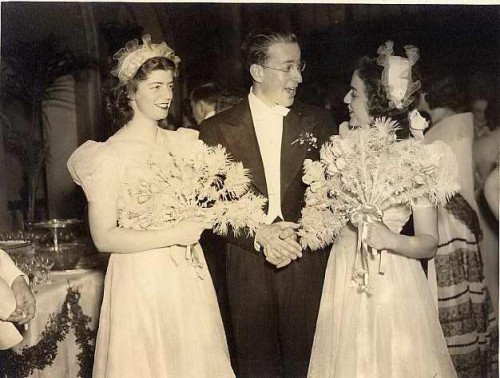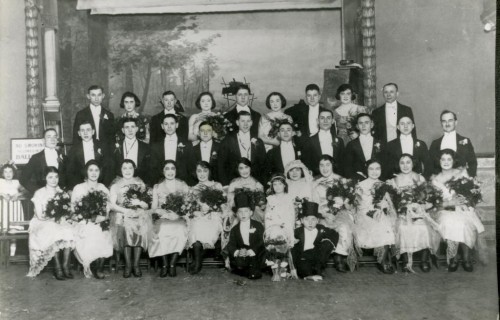The Bridesmaid Gown

Or, You’ll Wear It and Like It: A “Just Married!” Extra
Curators have to make choices: not everything can make it into an exhibit, and there’s seldom enough space to share every interesting fact about the things that are on display. That’s where social media comes in! Here’s a closer look at another “Just Married” story from JMM collections manager and Just Married! curator Joanna Church. To read more “Just Married!” extras, click here. To read more posts from Joanna, click here.

Though we have many wonderful wedding gowns in our collections, we do not, alas, have any dresses worn by bridesmaids or attendants. The closest we get is an adorable little flower girl dress from 1928. Thankfully, through photos and documents we can still get at what some of our wedding couples’ friends and family wore to the festivities … and what society (or Society) thought was appropriate.
Black and white photography, though stylish and elegant – and, of course, the cheapest (if not the only) option for many decades – does not convey the full glory of a bridesmaid dress; nor does mere description. But the descriptions are a lot of fun. For example, we can only imagine the rainbow array of gowns and trims worn by the attendants of Bessie Grossman Paymer (whose fashionable beaded silk wedding gown is included in “Just Married!”) at Hazazer’s Hall in 1911:
“The maid of honor was Miss Minnie Grossman of Philadelphia, a cousin of the bride, who was dressed in pink satin, draped in pink chiffon and embroidered with roses…. [As for the four bridesmaids,] Miss Evelyn Paymer wore a gown of white satin, draped in steel-studded chiffon, trimmed in crystal and white marabou. Miss Cecelia Paymer wore pink charmous [sic] satin, draped in blue chiffon and trimmed in crystal fringe. Miss Bessye Paymer wore turquoise-blue satin, draped with white chiffon and trimmed in pearls and white marabou. Miss Mary S. Levy wore yellow satin, draped in blue marquisette and trimmed in pearls and blue marabou.” –-The Baltimore Sun, January 22, 1911
Not only are these dresses elaborately trimmed (indeed, they sound like the 1910s version of today’s stereotypical “my friend made me wear dreadful giant bows” bridesmaid gown), they are each totally different. In more recent decades, many brides choose to garb their attendants in identical shades, but I rather like the idea of a multicolored entourage. And perhaps the bride was following the advice of an etiquette author such as Mrs. Humphrey, who wrote in Etiquette for Every Day (1904), “…a considerate girl [will not] be arbitrary about the colours chosen [for her bridesmaids]. She will take into account the various complexions and tints of hair of the girls who are to wear the dresses, and will good-naturedly endeavour to choose something that will suit them all; as well as a form of gown that will be likely to be useful on other occasions after her wedding.”
By the 1920s many etiquette guides were singing a different tune. Bridesmaids should emphatically not expect any such consideration from their friends, as stated in both Emily Holt’s Encyclopedia of Etiquette [(1921) and Emily Post’s Etiquette in Society, in Business, in Politics, and in the Home (1922). The former notes, “The bridesmaid and maid of honor must yield unquestioningly to the taste of the bride concerning the color, mode of making, and all the appointments of their wedding dresses.” Post gives similarly inflexible instruction, though she does add that while the dresses must all be of the same fabric and design, a bride may choose some complementary colors for different attendants to wear, particularly to differentiate the maid or matron of honor from the mere bridesmaids; nonetheless, she concludes, “bridesmaids’ dresses are looked upon as uniforms, not individual costumes.”
Thus at the wedding of Helen Brylawski and Baltimore’s Sidney Lansburgh, Jr. at the Mayflower Hotel in Washington, D.C., 1940, the bridesmaids were dressed all alike, with the matron of honor’s outfit having the colors reversed (as recommended by Emily Post). Two of the young women can be seen in the photo below. According to the Washington Post, at the Brylawski-Lansburgh wedding “Mrs. Arthur Lyon was matron of honor, wearing flesh-colored marquisette and a halo horsehair hat with ribbon streamers. The bridesmaids were Miss Therese Weil, of New Orleans; Miss Rosalie Lurvey, of Indianapolis; Miss Sylvia Glickman, of New York, and the Misses Elizabeth Hahn and Selma Friedman, of Washington. They were dressed in aquamarine marquisette and wore flesh-colored tulle hats with aqua streamers. All the attendants carried fans fashioned of pink roses.” —The Washington Post, June 13, 1940

As noted above, a black and white photo can’t really do these sartorial choices justice. Happily there are a few colorful examples, such as the movie taken at the wedding of Phyllis Kolker and A. Harvey Schreter on February 1, 1942 at the Lord Baltimore Hotel. Snippets of the film are included in “Just Married!” and the full movie, courtesy of MARMIA (Mid-Atlantic Regional Moving Image Archive), can be viewed here. Look for the Emily Post-approved reversal of colors, with the first young woman in a yellow satin gown with a wide blue ribbon on her bouquet, and the two attendants behind her in blue with yellow bouquet ribbons. (And yes, no doubt the designer, salesperson, and bride herself would have used fancier color names, but until I find the newspaper description, “blue” and “yellow” it is.)
There are of course many other variations on the ‘proper’ way to do things, both before and after these decades… too many to cover in this short post, which merely touches on a few of the trends of the early-mid 20th century. However, one thing seems to remain constant, no matter the era, and no matter whether the bride is following the dictates of fashion or her own inclination: As the author of The Social Mirror: A Complete Treatise on the Laws, Rules and Usages that govern our most Refined Homes and Social Circles noted in 1888, “The principal duty of the brides-maid is to look pretty, and not out-shine the bride.”

